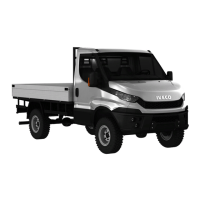DAILY 4x4 ‒ GUIDELINES FOR BODYBUILDERS
GENERAL INFORMATION
1.15 DIMENSIONS AND GROUND
15
– Printed 692.68.999 – 3 Ed. - Base 08-2020
c) Loads that result in increased aerodynamic actions
In fittings characterised by high vertical and surface development (e.g.: advertising panelling), the hight of the centre of thrust, de-
termined in the case of cross-wind, must be evaluated very carefully.
▶ Even with the low centre of gravity, a vehicle fitting that has a high surface area may not provide
sufficient lateral stability and may be exposed to the danger of tilting.
Special attention must therefore be paid:
● in defining the height of the fitted vehicle's centre of gravity and at full load,
● in assessing the aerodynamic forces,
● in prescribing the adoption of adequate precautions for driving.
Any cases where evaluation is difficult should be submitted to IVECO for approval.
1.15.6 Adoption of stabilizer bars
The application of additional or reinforced stabilizer bars, reinforcing the springs or flexible elements in rubber (in accordance with
the indications provided in Chapter 2.9 ) helps to compensate for any high values of the centre of gravity of the payload. In this
case, the operation must be carried out on the rear axle, since acting on the front may give rise to an incorrect sensation of higher
vehicle stability and higher safety limits. Interventions on the front axle can be carried out in the presence of concentrated loads
behind the cab (for example, cranes) or of superstructures with high rigidity (for example, vans).
1.15.7 Observance of the permitted masses
All the limits shown on IVECO documentation must be respected. It is particularly important to evaluate the maximum ground on
the front axle in any load condition, in order to ensure the necessary steering features in all road surface conditions.
Special attention must therefore be paid to vehicles with concentrated load on the rear overhang (e.g.: cranes, tail lifts, trailers with
centre axle) and short wheelbase vehicles and high centre of gravity.
Note
In the positioning of the auxiliary bodies and superstructure, a proper load distribution in the transverse direction must be ensured.
A variation on the nominal load may be permitted for each wheel (50% load on the corresponding axle) of
±
4% (e.g.: load allowed
on the axle 3,000 kg; allowed for each wheel side from 1,440 to 1,560 kg) in compliance with what is permitted by the tyres,
without affecting the braking and driving stability characteristics of the vehicle.
Unless other specific dispositions are provided for individual vehicles, one must consider for the mass on the front axle a minimum
value of 25% of the effective mass of the vehicle (with loads distributed uniformly as well as with loads on the rear overhang or
associated with a trailer, if attached).
Note
The rear overhang of the superstructure must be implemented in full compliance with the permitted axle loads, the minimum
load required on the front axle, length limits, the position of the tow hook and the under-run protection as envisaged by various
standards and regulations.

